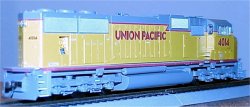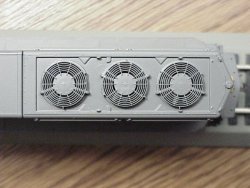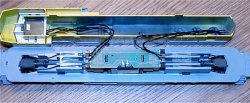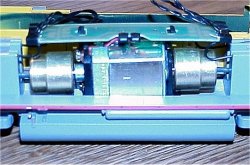Athearn Genesis HO SD70M 'Union Pacific' | | Background When new and improved technologies become available, there are always new products released to make use of them. Such was the case with the SD70 series. Evolved from the highly successful SD60, EMD incorporated the new 16 cylinder 710G3B engine rated at 4,000 horsepower, a new computer system with more power and capacity, a new traction motor, and the new HTC series radial truck. The HTC-R truck allows the engine to "steer" through turns, allowing for greater wheel life. Combining the HTC-R truck with the new traction motor, the SD70 had 20% more 'traction' over the SD60. While several railroads purchased the standard cab SD70, it didn't take long for the safety cab version, the SD70M to catch on and virtually end the use of the standard cab on future road engines. The first three new engines off of the EMD line were SD70M demonstrators, produced in 1992. These led to the adoption of the SD70 and SD70M among numerous railroads. In 1995, EMD added a few incremental improvements into the SD70 series, including the use of the upgraded 710G3C engine, rated at 4,300 horsepower. These new machines were designated SD75M for the safety cab version and SD75I for the units equipped with the isolated cab. Continued improvements in horsepower and computer power led to the SD80 series, and with the adoption of AC traction motors, led to the current generation of road engines from EMD, the SD70MAC, SD80MAC, and the 6,000 horsepower SD90MAC-H. The Engine  If you haven't seen one of these Athearn Genesis series engines yet, you haven't been paying attention. While the standard Athearn series that we know and love offered better engines in a variety of color schemes than the 'toy' engines on the market, they still lacked the details sought by the more sophisticated model railroader. This is understandable, as the Athearn line is still priced very reasonably, and the greater the detail, the higher the price. If you haven't seen one of these Athearn Genesis series engines yet, you haven't been paying attention. While the standard Athearn series that we know and love offered better engines in a variety of color schemes than the 'toy' engines on the market, they still lacked the details sought by the more sophisticated model railroader. This is understandable, as the Athearn line is still priced very reasonably, and the greater the detail, the higher the price.
This led to a major aftermarket industry to evolve, including names like Details West, A-Line, and Detail Associates to create a variety of specialized detail parts to transform the stock Athearn engine into something approaching the details of the brass engine market (without spending quite as much).  In order to fill the void between the 'basic' engines and the brass market, several companies have offered spectacular engines in plastic that weren't even imaged. Among these are the Genesis series of engines from Athearn. While Athearn has released two steam engines, their first diesel offering was the SD70M/SD75M/SD75I series. While this series has been on the market for a little while, Athearn has just filled a void in the power roster. In order to fill the void between the 'basic' engines and the brass market, several companies have offered spectacular engines in plastic that weren't even imaged. Among these are the Genesis series of engines from Athearn. While Athearn has released two steam engines, their first diesel offering was the SD70M/SD75M/SD75I series. While this series has been on the market for a little while, Athearn has just filled a void in the power roster.
Just released is a Union Pacific SD70M that sports the new 'zip' stripe along the side and the newly reinstated UP winged shield on the nose. One thing you'll also notice with the Genesis series engines, there is no bleed-over between paint colors, and there is no fade or bleed-through on their markings. Everything is virtually perfect. This is also true for this new Union Pacific release.  Let's talk about details. How about individual grab irons? How about leaner, flexible railings that don't stay bent like the older wire types? When you get a little closer, you'll spot the photo-etched grill over the dynamic brake, the open engine exhaust stack, and the metal radiator grilles that reveal Q-fans underneath. In the cab, you'll even find a nice interior. The only thing you won't find is a crew, but that is easily rectified. The engine is even equipped with a snow plow and operating ditch lights! Let's talk about details. How about individual grab irons? How about leaner, flexible railings that don't stay bent like the older wire types? When you get a little closer, you'll spot the photo-etched grill over the dynamic brake, the open engine exhaust stack, and the metal radiator grilles that reveal Q-fans underneath. In the cab, you'll even find a nice interior. The only thing you won't find is a crew, but that is easily rectified. The engine is even equipped with a snow plow and operating ditch lights!
 Under the hood, the Genesis is definitely a whole new ballgame. The frame is completely redesigned to be compliant with NMRA Digital Command & Control (DCC) standards. Unlike the standard series of Athearn engines, this motor is not grounded to the frame, so power from each truck is fed with two leads now instead of one. This reduces noise caused from the metal-rubbing-metal power transfer system used on the standard series. Under the hood, the Genesis is definitely a whole new ballgame. The frame is completely redesigned to be compliant with NMRA Digital Command & Control (DCC) standards. Unlike the standard series of Athearn engines, this motor is not grounded to the frame, so power from each truck is fed with two leads now instead of one. This reduces noise caused from the metal-rubbing-metal power transfer system used on the standard series.
Speaking of motors, Athearn has also installed a Bueller can motor along with a new driveline and dual flywheels. The engine runs whisper quiet at nearly all speed settings and requires very little power to start 'crawling.'  Something else you'll notice under the hood - it is very clean under there. The mechanical layout is much nicer that almost any other diesel I've seen to date. Wiring is also laid out beautifully, thanks to dedicated wire channels in the frame and having all wiring terminate on a central circuit card. Something else you'll notice under the hood - it is very clean under there. The mechanical layout is much nicer that almost any other diesel I've seen to date. Wiring is also laid out beautifully, thanks to dedicated wire channels in the frame and having all wiring terminate on a central circuit card.
As I mentioned earlier, the Genesis series is designed to be DCC-ready. The central circuit card serves to route power from the rails to the motor and provide directional lighting. To convert the engine to DCC, you replace the circuit card with a DCC module designed to literally plug and play. The Digitrax DH150A, the NCE DA-SR, as well as decoder cards from Soundtraxx and Atlas will all work perfectly. You simply unclip the wires from the old circuit card and clip them to the same spot on the DCC circuit card. The Genesis engines actually use two tiny light bulbs in each headlight unit (as opposed to a larger bulb shining into a clear plastic part that simulates two bulbs). These bulbs are 1.5 volts, with power regulation provided on the circuit card to keep them from burning out at higher speeds/voltages, yet providing constant brightness at virtually all power settings. To convert to DCC operations, you'll have to install a resistor in series with the lights or replace the lights with 12 volt bulbs. This also applies to the ditch lights. Operations As I mentioned earlier, the SD70M operates whisper quiet at all speed settings, with only a slight hum at high power settings. This may only be temporary, until the engine has had a chance to break in. I'll report back on this when we do a follow-up article covering the installation of the Athearn-supplied detail parts, the Details West SD70/75 detail set, and a DCC decoder. Acceleration is very smooth, as is deceleration. The flywheels are very effective for smooth momentum when power is abruptly removed. Conclusions If you're a fan of current motive power, the Athearn Genesis SD70/75M series is a must-have for the HO model railroader. Even if you're a fan of older diesels, you might want to cheat and play with one of these. If not, you're still in luck! Athearn is currently releasing the F-series of EMD engines in the Genesis line, so the engineering and detail should be equally spectacular. And for those of you who remain steadfast to the steam era, Athearn has two different engines to suit your fancies as well. Whichever you choose, you won't be disappointed! As a footnote, you may have hesitated to buy one of these great engines due to the $115 USD retail price tag. While this engine is worth every penny, and I did buy one at full price immediately after these were released, there are now some bargains to be had out there. Average price for an SD70/75 on eBay is around $79 USD, but with a watchful eye and some patience, you can find this engine for between $50 and $60 USD, still new in the box. My local hobby store, Hobbyland, is currently offering 40% off retail on the Genesis series, while an online shop, aplushobbies.com, is offering the SD70/75 for $51.74! Good hunting! | 


 



  
    |

 If you haven't seen one of these Athearn Genesis series engines yet, you haven't been paying attention. While the standard Athearn series that we know and love offered better engines in a variety of color schemes than the 'toy' engines on the market, they still lacked the details sought by the more sophisticated model railroader. This is understandable, as the Athearn line is still priced very reasonably, and the greater the detail, the higher the price.
If you haven't seen one of these Athearn Genesis series engines yet, you haven't been paying attention. While the standard Athearn series that we know and love offered better engines in a variety of color schemes than the 'toy' engines on the market, they still lacked the details sought by the more sophisticated model railroader. This is understandable, as the Athearn line is still priced very reasonably, and the greater the detail, the higher the price.  In order to fill the void between the 'basic' engines and the brass market, several companies have offered spectacular engines in plastic that weren't even imaged. Among these are the Genesis series of engines from Athearn. While Athearn has released two steam engines, their first diesel offering was the SD70M/SD75M/SD75I series. While this series has been on the market for a little while, Athearn has just filled a void in the power roster.
In order to fill the void between the 'basic' engines and the brass market, several companies have offered spectacular engines in plastic that weren't even imaged. Among these are the Genesis series of engines from Athearn. While Athearn has released two steam engines, their first diesel offering was the SD70M/SD75M/SD75I series. While this series has been on the market for a little while, Athearn has just filled a void in the power roster.  Let's talk about details. How about individual grab irons? How about leaner, flexible railings that don't stay bent like the older wire types? When you get a little closer, you'll spot the photo-etched grill over the dynamic brake, the open engine exhaust stack, and the metal radiator grilles that reveal Q-fans underneath. In the cab, you'll even find a nice interior. The only thing you won't find is a crew, but that is easily rectified. The engine is even equipped with a snow plow and operating ditch lights!
Let's talk about details. How about individual grab irons? How about leaner, flexible railings that don't stay bent like the older wire types? When you get a little closer, you'll spot the photo-etched grill over the dynamic brake, the open engine exhaust stack, and the metal radiator grilles that reveal Q-fans underneath. In the cab, you'll even find a nice interior. The only thing you won't find is a crew, but that is easily rectified. The engine is even equipped with a snow plow and operating ditch lights!  Under the hood, the Genesis is definitely a whole new ballgame. The frame is completely redesigned to be compliant with NMRA Digital Command & Control (DCC) standards. Unlike the standard series of Athearn engines, this motor is not grounded to the frame, so power from each truck is fed with two leads now instead of one. This reduces noise caused from the metal-rubbing-metal power transfer system used on the standard series.
Under the hood, the Genesis is definitely a whole new ballgame. The frame is completely redesigned to be compliant with NMRA Digital Command & Control (DCC) standards. Unlike the standard series of Athearn engines, this motor is not grounded to the frame, so power from each truck is fed with two leads now instead of one. This reduces noise caused from the metal-rubbing-metal power transfer system used on the standard series.  Something else you'll notice under the hood - it is very clean under there. The mechanical layout is much nicer that almost any other diesel I've seen to date. Wiring is also laid out beautifully, thanks to dedicated wire channels in the frame and having all wiring terminate on a central circuit card.
Something else you'll notice under the hood - it is very clean under there. The mechanical layout is much nicer that almost any other diesel I've seen to date. Wiring is also laid out beautifully, thanks to dedicated wire channels in the frame and having all wiring terminate on a central circuit card. 






